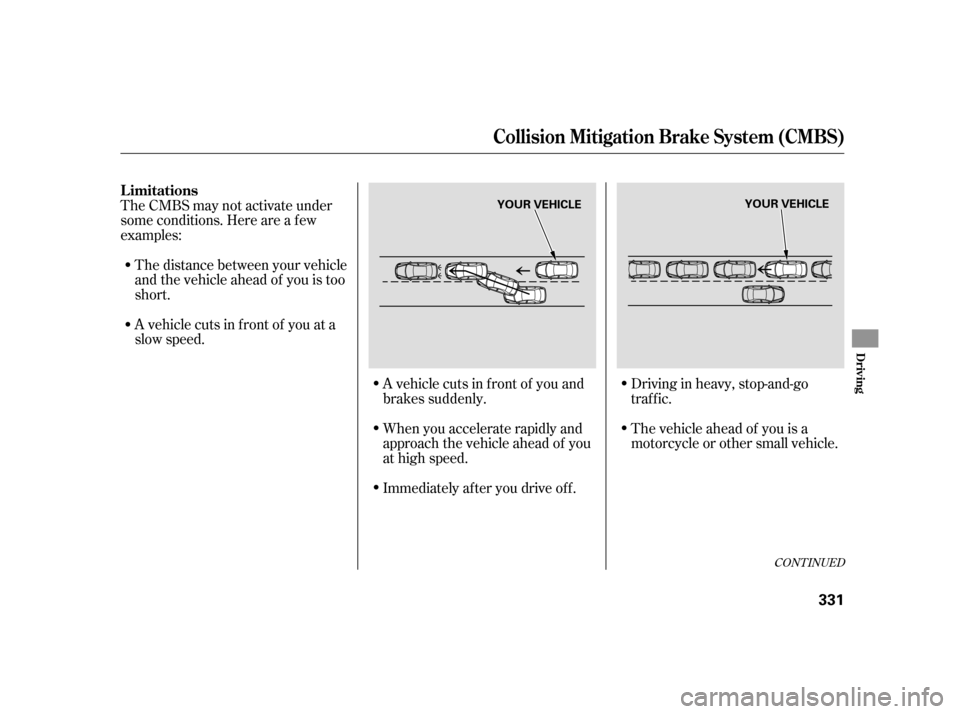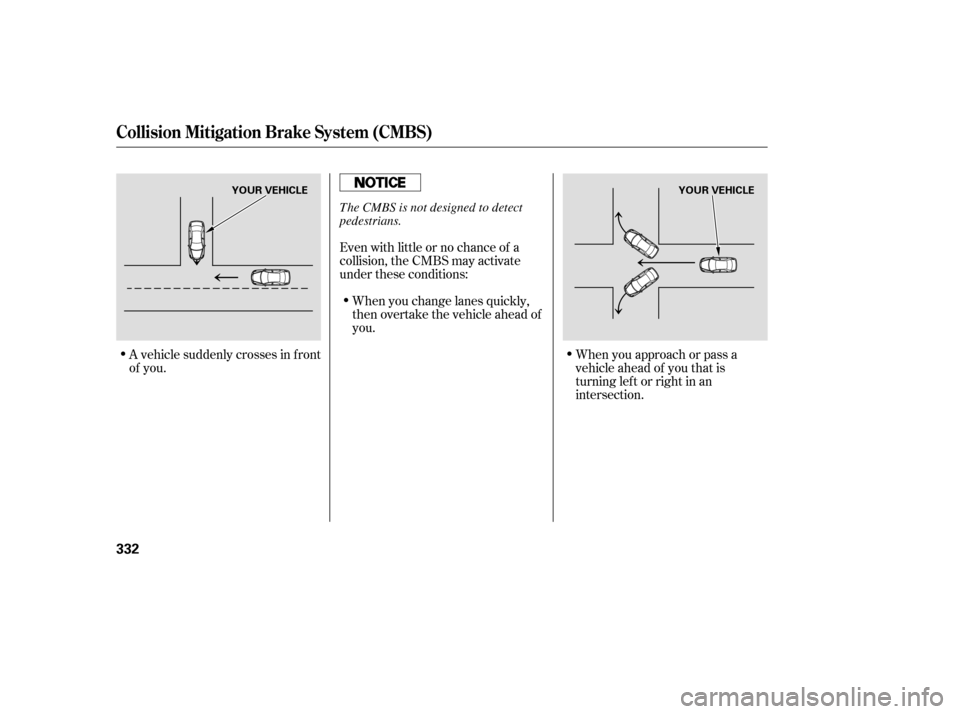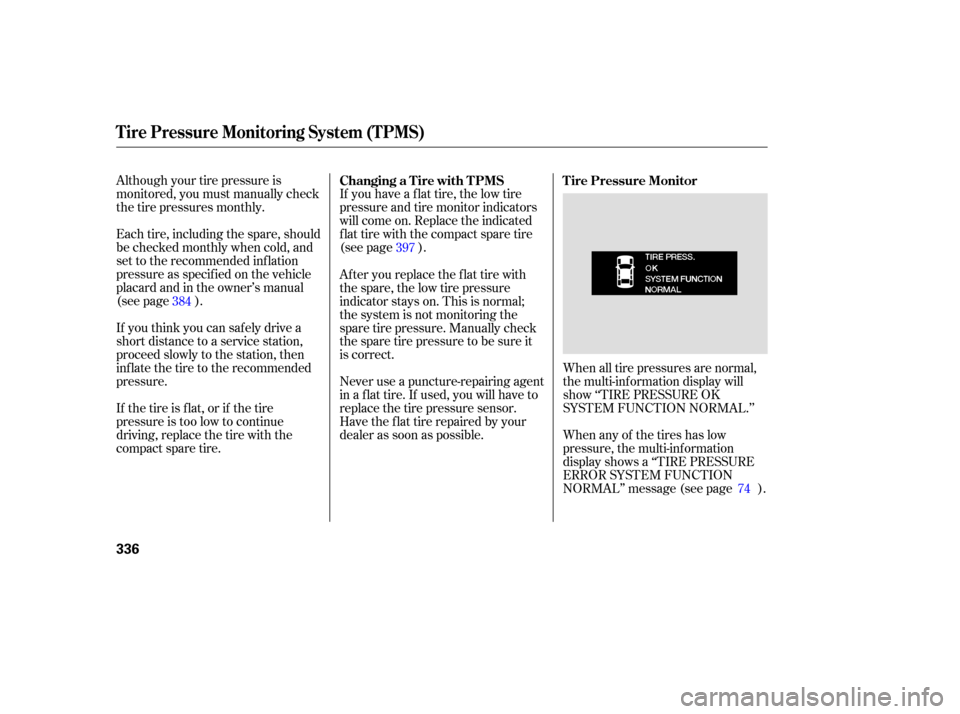Acura RL 2006 Owner's Manual
Manufacturer: ACURA, Model Year: 2006, Model line: RL, Model: Acura RL 2006Pages: 454, PDF Size: 5.58 MB
Page 331 of 454

The CMBS indicator normally comes
on under these conditions:When you manually turn of f the
system.
When the system shuts off
automatically.
When you drive in bad weather
(rain, snow, f og, etc.). When the VSA system indicator
comes on (see page ).
When you turn the ignition switch
to the ON (II) position, the CMBS
indicator should come on f or a f ew
seconds, then go of f . If the
indicator comes on at any other
time and a CHECK CMBS
SYSTEM message appears on the
multi-inf ormation display, there is
a problem with the CMBS. You
can still drive your vehicle, but
CMBS will not be operating. Have
your vehicle checked by a dealer.
To turn the CMBS back on, make
sure the vehicle is stopped and the
ignition switch is in the ON (II)
position, then press the CMBS OFF
switch f or about 1 second.
If anything covers the f ront grille
(dirt, mud, dry leaves, wet snow,
etc.). 339
Collision Mitigation Brake System (CMBS)
330
Page 332 of 454

CONT INUED
A vehicle cuts in f ront of you and
brakes suddenly.
When you accelerate rapidly and
approach the vehicle ahead of you
at high speed.Driving in heavy, stop-and-go
traffic.
The vehicle ahead of you is a
motorcycle or other small vehicle.
Immediately af ter you drive of f .
The CMBS may not activate under
some conditions. Here are a f ew
examples:
The distance between your vehicle
and the vehicle ahead of you is too
short.
A vehicle cuts in f ront of you at a
slow speed.
Collision Mitigation Brake System (CMBS)
Limitations
Driving
331
YOUR VEHICLE
YOUR VEHICLE
Page 333 of 454

Even with little or no chance of a
collision, the CMBS may activate
under these conditions:
A vehicle suddenly crosses in f ront
of you. When you approach or pass a
vehicle ahead of you that is
turning lef t or right in an
intersection.
When you change lanes quickly,
then overtake the vehicle ahead of
you.
Collision Mitigation Brake System (CMBS)
332
YOUR VEHICLE
YOUR VEHICLE
The CMBS is not designed to detect
pedestrians.
Page 334 of 454

CONT INUED
When you pass a low bridge at
high speed.
When you go over a sharp-edged
speed bump at high speed.When you approach train tracks at
the bottom of a hill and you do not
apply the brakes.
Because of the road condition
(curved, winding, etc.) or the state of
your vehicle (turning angle, lane
position, etc.), CMBS can sometimes
mistake a stationary object (light
pole, traf f ic sign, etc.) as a vehicle
ahead of you and temporarily
operate. This is normal.
Collision Mitigation Brake System (CMBS)
Driving
333
LOW BRIDGE
RAILS YOUR VEHICLE
SIGN, POLE, etc.
Page 335 of 454

As required by the FCC:This device complies with Part 15 of theFCC rules. Operation is subject to thef ollowing two conditions: (1) This devicemay not cause harmf ul interf erence, and(2) this device must accept anyinterf erence received, includinginterf erence that may cause undesiredoperation.
Changes or modif ications not expresslyapproved by the party responsible f orcompliance could void the user’sauthority to operate the equipment.
This device complies with IndustryCanada Standard RSS-210.Operation is subject to the f ollowing twoconditions: (1) this device may not causeinterf erence, and (2) this device mustaccept any interf erence that may causeundesired operation of the device.
Themainpurposeof theCMBSisto
reduce the severity of injuries
caused by an unavoidable collision.
While the CMBS may help to alert
you and minimize the severity of a
collision, it may not activate in every
dangerous situation.
Even with the CMBS, it is still your
responsibility to operate the brake
pedal and steering wheel
appropriately, according to the
driving conditions.
Collision Mitigation Brake System (CMBS)
Important Saf ety Reminder
334
Page 336 of 454

Your vehicle is equipped with a tire
pressure monitoring system (TPMS)
that turns on every time you start the
engine and monitors the pressure in
your tires while driving.
Each tire has its own pressure
sensor. If the air pressure of a tire
becomes signif icantly low, the
sensor in that tire immediately sends
a signal that causes the low tire
pressure indicator in the
instrumental panel and the
appropriate tire position indicator on
thetirepressuremonitoronthe
multi-inf ormation display (see page)tocomeon. For example, if you check and f ill
your tires in a warm area, then drive
in extremely cold weather, the tire
pressure will be lower than
measured and could be underinflated
and cause the low tire pressure
indicator to come on. Or, if you
check and adjust your tire pressure
in cooler conditions, and drive into
extremely hot conditions, the tire
maybecomeoverinflated.However,
the low tire pressure indicator will
not come on if the tires are
overinf lated.
When the low tire pressure indicator
is on, one or more of your tires is
signif icantly underinf lated. The
multi-inf ormation display also shows
a ‘‘CHECK TIRE PRESSURE’’
message (see page ). You should
stop and check your tires as soon as
possible, and inflate them to the
proper pressure as indicated on the
vehicle’s tire inf ormation placard.
Driving on a signif icantly under-
inf lated tire causes the tire to
overheat and can lead to tire failure.
Under-inf lation also reduces f uel
efficiency and tire tread life, and may
af f ect the vehicle’s handling and
stopping ability.
Becausetirepressurevariesby
temperature and other conditions,
the low tire pressure indicator may
come on unexpectedly.
Refer to page for tire inflation
guidelines.
383
336 335
CONT INUED
Low Tire Pressure
Indicator
Tire Pressure Monitoring System (TPMS)
Driving
335
Page 337 of 454

Although your tire pressure is
monitored, you must manually check
thetirepressuresmonthly.If you have a f lat tire, the low tire
pressure and tire monitor indicators
will come on. Replace the indicated
flat tire with the compact spare tire
(see page ).
When all tire pressures are normal,
the multi-information display will
show ‘‘TIRE PRESSURE OK
SYSTEM FUNCTION NORMAL.’’
Each tire, including the spare, should
be checked monthly when cold, and
set to the recommended inf lation
pressure as specif ied on the vehicle
placard and in the owner’s manual
(see page ).
If you think you can saf ely drive a
short distance to a service station,
proceed slowly to the station, then
inflate the tire to the recommended
pressure.
If the tire is f lat, or if the tire
pressure is too low to continue
driving, replace the tire with the
compact spare tire.
When any of the tires has low
pressure, the multi-inf ormation
display shows a ‘‘TIRE PRESSURE
ERROR SYSTEM FUNCTION
NORMAL’’ message (see page ).
After you replace the flat tire with
the spare, the low tire pressure
indicator stays on. This is normal;
the system is not monitoring the
spare tire pressure. Manually check
the spare tire pressure to be sure it
is correct.
Never use a puncture-repairing agent
in a f lat tire. If used, you will have to
replace the tire pressure sensor.
Havetheflattirerepairedbyyour
dealer as soon as possible.
384
397
74
Changing a T ire with T PMS T ire Pressure Monitor
Tire Pressure Monitoring System (TPMS)
336
Page 338 of 454

CONT INUED
If there is a system error with the
TPMS, the multi-inf ormation display
showsa‘‘SYSTEMFUNCTION
ERROR’’ message (see page ),
and the tire pressure readings will
not be displayed. You will also see a
‘‘CHECK TPMS SYSTEM’’ message
on the multi-information display (see
page ).If any of the tires have low pressure,
the multi-information display will
show a ‘‘CHECK TIRE PRESSURE’’
message. You will also see one or
more low pressure tire positions
blinking in the display (see page
). When the TPMS is functioning
normally, you can press the SEL/
RESETbuttononthesteeringwheel
to see the pressure readings of each
tire in psi (U.S. models) or kPa
(Canadian models) (see page ).
78
338 335
76
Tire Pressure Monitoring System (TPMS)
T ire Pressure Readings
Driving
337
VEHICLE ICONU.S.
Page 339 of 454

If one or more tires have low
pressure, the low tire pressure
indicator on the instrument panel
also comes on (see page ).
When cruise control is on while
driving, the pressure reading cannot
be checked by the tire pressure
monitor on the multi-inf ormation
display.If there is a problem with the TPMS,
the multi-information display shows
a ‘‘CHECK TPMS SYSTEM’’
message (see page ). If you see
this message, the system is not
monitoring tire pressure. Have your
vehicle checked by a dealer as soon
as possible.If the low tire pressure indicator
comes on, or the multi-information
display shows a ‘‘CHECK TPMS
SYSTEM’’ message, the VSA system
automatically turns on even when
the VSA system is turned of f by
pressing the VSA OFF switch (see
page ). If this happens, you
cannot turn the VSA system of f by
pressing the VSA OFF switch again.
335 340
79
Tire Pressure Monitoring System (TPMS)
Check T PMS System Message
338
CANADA
Page 340 of 454

When VSA activates, you will see the
VSA activation indicator blink (see
page ).
If this indicator comes on while
driving, pull to the side of the road
when it is saf e, and turn of f the
engine. Reset the system by
restarting the engine. If the VSA
system indicator stays on, or comes
back on while driving, have the VSA
system inspected by your dealer.
If the indicator does not come on
when the ignition switch is turned to
the ON (II) position, there may be a
problem with the VSA system. Have
your dealer inspect your vehicle as
soon as possible (see page ).
The vehicle stability assist (VSA)
system helps to stabilize the vehicle
during cornering if the vehicle turns
more or less than desired. It also
assists you in maintaining traction
while accelerating on loose or
slippery road surf aces. It does this
by regulating the engine’s output and
by selectively applying the brakes.
When VSA activates, you may notice
that the engine does not respond to
the accelerator in the same way it
does at other times.
The VSA system cannot enhance the
vehicle’s driving stability in all
situations and does not control your
vehicle’s entire braking system. It is
still your responsibility to drive and
corner at reasonable speeds and to
leave a sufficient margin of safety.
65
65
Changes or modif ications not expressly
approved by the party responsible f orcompliance could void the user’sauthority to operate the equipment.
This device complies with IndustryCanada Standard RSS-210.Operation is subject to the f ollowing twoconditions: (1) this device may not causeinterf erence, and (2) this device mustaccept any interf erence that may causeundesired operation of the device.
As required by the FCC:
This device complies with Part 15 of theFCC rules. Operation is subject to thef ollowing two conditions: (1) This devicemay not cause harmf ul interf erence, and(2) this device must accept anyinterf erence received, includinginterf erence that may cause undesiredoperation.
CONT INUED
VSA A ctivation Indicator
VSA System Indicator
Vehicle Stability Assist (VSA)
System
Tire Pressure Monitoring System (TPMS), Vehicle Stability A ssist (VSA ) System
Driving
339